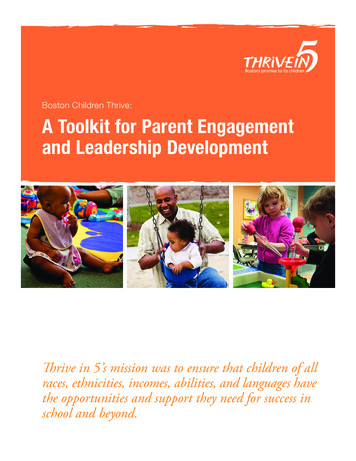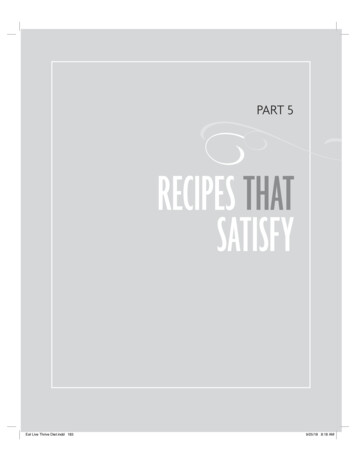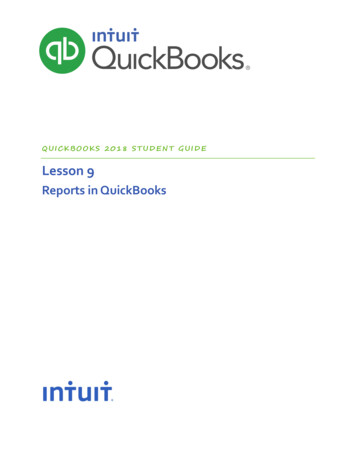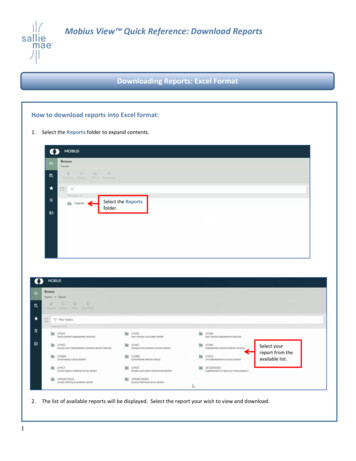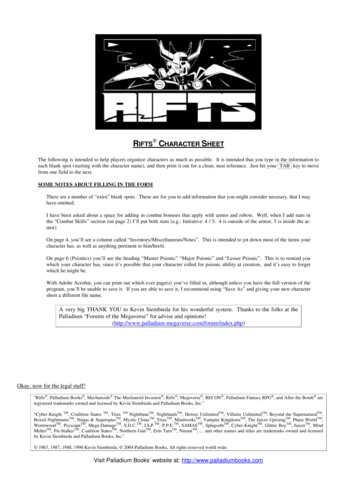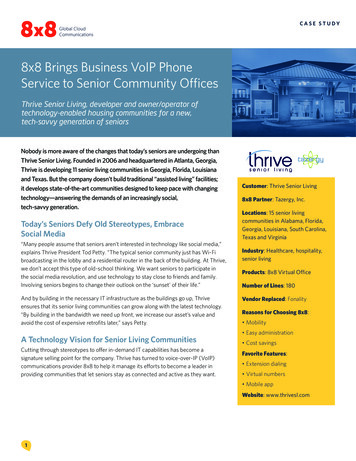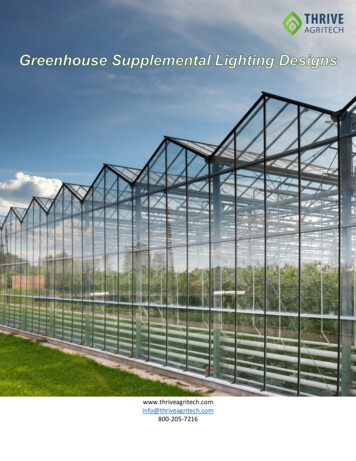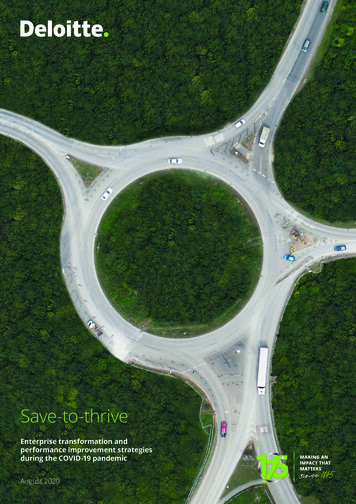
Transcription
Save-to-thriveEnterprise transformation andperformance improvement strategiesduring the COVID-19 pandemicAugust 2020
Save-to-Thrive Enterprise transformation and performance improvement strategies during the COVID-19 pandemicContentsExecutive summary4About the survey9Key global insights17Coping with COVID-19:Respond-Recover-Thrive23The “Next Normal”—New business conditionsafter COVID-1929Industry sector analysis35Save-to-Thrive39Conclusion42Appendix47
Save-to-Thrive Enterprise transformation and performance improvement strategies during the COVID-19 pandemicForewordThe COVID-19 pandemic is reshaping the global business landscape and fundamentally changinghow people around the world live and work. To better understand the short- and long-term impactsof the crisis—and what companies around the world are doing about it—we recently conducted aspecial mid-cycle version of our regular biennial survey of global cost management practices andtransformation trends.Actions that companies are taking right now to address COVID-19can have a major impact on their long-term competitiveness andperformance. As such, it is crucial for decision-makers to understandhow the crisis is unfolding from a business perspective, and what thefuture is likely to hold.The results of this mid-cycle survey include responses from1,089 executives with direct involvement in their companies’ costmanagement and enterprise transformation efforts, and represent abroad range of industries and global geographies—with particularlystrong representation from countries that have been highly impactedby COVID-19.In this report, we discuss the key survey findings using a three-stageframework (Respond-Recover-Thrive) to analyze companies’ actionsand expectations as they cope with the pandemic and positionthemselves for the post-crisis world (the “next normal”).Our 2019 global survey1, which was conducted prior to COVID-19,found the prevailing mindset for strategic cost management was“Save-to-Transform” (using the strategic levers of cost, growth, talent,technology and digital enablement to transform how companiesdo business). Now, in response to COVID-19, we are seeing thattransformation mindset evolve into “Save-to-Thrive,” with thecrisis shining extra light on the talent lever and accelerating keytransformation actions such as automation and remote work thatcan help companies thrive once the virus is contained and the nextnormal emerges.In contrast to the downturn that began in 2008, which was structuralin nature, the current crisis was triggered by external factors and isdemand-driven. As such, although two-thirds of our respondentsexpect at least one more wave of COVID-19 relapses to occur,companies around the world are generally optimistic about thefuture and intend to bounce back as quickly as possible, adoptinga Save-to-Thrive mindset that can help them make strategic shiftsto their operating models, products and services, and customerengagement capabilities.We hope you find the insights in this special report useful, and lookforward to hearing your thoughts and feedback.Omar AguilarStrategic Cost TransformationGlobal Market Offering LeaderDeloitte Consulting LLPSam BalajiGlobal Consulting LeaderDeloitte Touche Tohmatsu Limited1. “Save-to-Transform as a catalyst for embracing digital disruption: Deloitte’s second biennial global cost survey,” Deloitte, 20193
Save-to-Thrive Enterprise transformation and performance improvement strategies during the COVID-19 pandemicExecutive summaryExpectations forpositive revenuegrowth have declinedsignificantly due toCOVID-19. Comparedto pre-COVID-19expectations, thepercentage ofrespondents globallyexpecting positiverevenue growth isdown 40 points.COVID-19 is boostingthe focus on costreduction. Relative topre-COVID-19 levels,the likelihood ofundertaking costreduction initiativesincreased globallyby 74% (28 percentagepoints). Two of threecompanies globally(66%) now expect topursue cost reductionover the next 12months, up from just38% reported beforeCOVID-19.Cost structure isconsidered the topinternal challenge.Inability to adjust coststructure to meetdemand is the topinternal challenge globallyand in all regions. Inabilityto meet employeesafeguards, and inabilityto satisfy increaseddemand round out thetop three.Inability to rapidlyaddress cost structureto meet demand: 78%Inability to meethigher measuresrelated to employeesafeguards: 74%Inability to satisfyincreased demandor increased salesopportunities: 71%Lack of liquidityor credit to ensurebusiness continuity:69%4COVID-19 financialimpacts are demanddriven. The topexternal challengesreported globally are:drop in consumerdemand (74%); shiftin consumer behavior(67%); cyber securityvulnerabilities (65%),and supply chainchallenges (65%).The crisis is drivingmore companies topursue aggressivecost reductiontargets. Globally,the percentage ofrespondents pursuingcost reduction targetsgreater than 10%increased by 61%(25 percentage points)compared to preCOVID-19 levels. Twoof three companiesglobally (66%) nowhave cost reductiontargets that exceed10%. Regionally, thepercentage of companieswith those aggressivetargets is highest inLATAM (83%) and lowestin the US (59%).
Save-to-Thrive Enterprise transformation and performance improvement strategies during the COVID-19 pandemicCoping with COVID-19:Respond-Recover-ThriveRequired actions to address the COVID-19 crisis can be divided into three major stages: respond, recover and thrive. These three stages areinterspersed with two additional interim stages (“respond to recover” and “recover to thrive”, and culminate in a long-term operating environment wecall the “next normal.”The global focus forthe COVID-19 crisis isshifting from respondto recover. Mostcompanies globally haveeffectively respondedto the immediate crisisand are now starting tofocus on recovery. Themajority of companiessurveyed (59%) nowsee themselves in the“respond to recover” or“recover” stages.Revenue growthexpectations are verypositive in the thrivestage. Expectations forrevenue growth, althoughdown from pre-COVID-19levels, remain somewhatpositive in the respondstage (55%) and recoverstage (58%). In thethrive stage, the vastmajority of companiesglobally (74%) and in allregions have a positiverevenue outlook.Automation is thetop transformationaction arising from theCOVID-19 crisis. Globallyand across all regions,roughly two of threecompanies expect topursue automationin all three stages ofRespond-Recover-Thrive.Working through allstages is expectedto require about a yearand a half. Although theexpected durations foreach stage vary widelyby region, on averagerespondents globallyexpect the respondstage to last aboutthree months, therecover stage about sixmonths, and the thrivestage about 10 months.5
Save-to-Thrive Enterprise transformation and performance improvement strategies during the COVID-19 pandemicThe “Next Normal”—New business conditions after COVID-19When mapping out strategies to respond, recover, and thrive, it helps to have informed insights about the future business environment. In the wakeof the 2008 financial crisis, many people called the resulting business environment the “new normal.” However, every new normal eventually getsreplaced by a new new normal, so in our view it makes sense to call the post-COVID business environment the next normal.Revenue sources willbe fundamentallydifferent in the nextnormal.Due to practices suchsocial distancing andshelter-in-place thatrestrict access to thephysical world, theCOVID-19 crisis hasgreatly acceleratedthe shift from physicalto digital channels. Ithas also revealed thelimitations and risks ofglobalization and globalsupply chains, leadingmany companies tore-prioritize domesticoperations overinternational operations.Meanwhile, COVIDdriven changes to howpeople live and work areboosting demand fornew kinds of productsand services. Accordingto the survey results,the fastest growingrevenue sources inthe future will be:digital channels (vs.physical channels); newproducts and services(vs. existing preCOVID offerings); anddomestic operations(vs. internationaloperations).6IT infrastructure,remote work anddigital channels areexpected to be thetop operating modelpriorities. In a postcrisis, increasingly digitalworld, IT infrastructureand digital channels willbe key. Also, remotework will likely remainpopular now that theCOVID crisis has provenits viability. Globally, thetop operating modelpriorities during the nextnormal are expectedto be: enhance ITinfrastructure (78%);enable remote work(76%); and enable presale, sale, and postsale activities throughdigital channels (72%).Top product strategiesfor the next normalfocus on innovation,health and safetymeasures, andcustomization.Globally, the top productstrategies to competein the next normal are:adjust, redesignor innovate yourproduct/serviceoffering to expandto adjacent and/ornew markets (74%);leverage new healthand safety measuresby redesigning yourcurrent product/service offering(73%); and customizeproducts or servicesto meet new customerand/or governmentrequirements (73%).Next normal customerengagement strategieswill be driven by digitalchannels and flexiblecustomer experiences.Globally, the mostpopular strategies forcustomer engagementwill be: shift mosttransactions to digitalchannels (75%), andincrease flexibilitybefore and after thesale (73%).Cybersecurity andcloud will be the keytechnologies.According to the survey,the most relevanttechnologies in thenext normal will becybersecurity solutions(80%) and cloudcomputing (80%).
Save-to-Thrive Enterprise transformation and performance improvement strategies during the COVID-19 pandemicIndustry sector analysisExpected growthimpacts over thenext 12 months varyby sector. Revenueexpectations over thenext 12 months varywidely by sector, withthe COVID-19 crisisimpacting sectorsboth negatively andpositively. On theDifferent sectorsare at differentstages of progress.In addressing thechallenges of COVID-19,the average rate ofprogress in all sectorsfalls somewherebetween the respondand recover stages.The median progressRevenue outlooksvary significantly byindustry. Althoughthe future revenueoutlook remainsgenerally positive forall sectors—especiallyin the thrive stage—expectations varysignificantly by sector.In the respond stage,the most negativerevenue outlooks, whileMedical Technology andPharmaceuticals have themost positive outlooks.In the thrive stage,Hospitality, Chemicals& Specialty Materials,and Hardware &Semiconductors have themost negative outlooks,negative side of thespectrum, a relativelyhigh percentage of sectorrespondents expectrevenue to decline inTransportation (61%) andHospitality (60%). On thepositive side, revenuegrowth is expected inMedical Technology(63%), Telecom (58%),Pharmaceuticals (58%),and Software & ITServices (57%).in sectors such asHospitality, CapitalMarkets, and MedicalTechnology is skewedtowards the respondstage, while sectorssuch as Insurance(both General and Life/Annuity), ConsumerProducts, and Bankingare generally furtheralong, with progressskewed toward therecover stage.Transportation andConsumer Productshave the most negativerevenue outlooks, whileMedical Technologyand Pharmaceuticalshave the most positiveoutlooks. In the recoverstage, Transportation andHospitality havewhile Medical Technologyand Telecom have themost positive outlooks.Most companiesexpect a secondwave of COVID-19.The majority ofrespondents (67%)expect a COVID-19relapse, with anestimated timeframeof early 2021. Thosethat follow strategiesconsistent with Save-toThrive will likely be theones best positionedto weather potentialchallenges resultingfrom a second wave.Decisions thatcompanies maketoday to cope withthe COVID-19 crisiscan help or hindertheir positioningfor the future. Byusing cost reductionand performanceimprovement strategicallyto transform theenterprise and improvecompetitiveness—whichincludes investing inkey capabilities suchas automation andSave-to-ThriveSave-to-Transformis becoming Save-toThrive. The strategicpriorities associatedwith the COVID-19thrive stage are veryconsistent with theSave-to-Transformtrend we identifiedin 2019, which usesthe strategic levers ofcost, growth, talent,technology and digitalenablement to transformhow companies dobusiness. And ascompanies bounce backfrom the COVID-19 crisisand position themselvesto thrive in the nextnormal, many expectto continue focusing onthose same levers—butwith an increased andaccelerated emphasis ontechnology and digitalenablement, along witha renewed emphasis ongrowth and talent. Wecall this evolved mindset“Save-to-Thrive.”remote work thatalign with the newrealities of a post-crisisbusiness environment—companies canleverage their costsavings andimprovement effortsto not only transformhow they operate, butto position themselvesto thrive in the nextnormal.7
Save-to-Thrive Enterprise transformation and performance improvement strategies during the COVID-19 pandemic8
Save-to-Thrive Enterprise transformation and performance improvement strategies during the COVID-19 pandemicAbout the survey9
Save-to-Thrive Enterprise transformation and performance improvement strategies during the COVID-19 pandemicAbout the surveyDeloitte Consulting LLP (Deloitte or Deloitte Consulting) engaged Dynata toconduct a global survey of COVID-19’s impact on organizations—from both atransformation and performance improvement perspective—to betterunderstand the changes taking place in current and future actions acrossregions and industries.Study objectivesConduct a mid-cycle version ofour biennial global cost survey,focusing on the impact of COVID-19Understand the impact ofCOVID-19 on different industrysectors and regionsCharacterize organizationsbased on three stages of activity:Respond, Recover and ThriveCompare businessexpectations before theCOVID-19 pandemic and nowIdentify trends on futureoperating models, product/service offerings andconsumer engagement in apost-COVID-19 world that wecall the “next normal.MethodologyData was collected through detailed online surveys conducted between late June and mid-July 2020.Analyses were conducted by ustSeptemberOctoberNovemberDecember
Save-to-Thrive Enterprise transformation and performance improvement strategies during the COVID-19 pandemicFirmographicsThe survey included responses from 1,089 executives directly involved intransformation efforts in their organizations. Respondents were from fourmajor regions.Figure 1. Geographic distribution of survey respondentsUS308 responsesEurope394 responsesAPAC268 responsesUK (124)Germany (79)Spain (70)Italy (70)France (51)China–Mainland (78)China–Hong Kong SAR (44)Japan (48)Australia (44)India (44)New Zealand (10)LATAM119 responsesBrazil (72)Mexico (47)11
Save-to-Thrive Enterprise transformation and performance improvement strategies during the COVID-19 pandemicSurveyed countries are highly representative of their regions and the overall global economy,in addition to representing geographies highly impacted by COVID-19The countries included in the survey represent 70% of the world’s economy as measured by GrossDomestic Product (GDP)*. Outside of the United States, respondents represent 54% to 88% of theirregional economies as measured by GDP (see Figure 2).Figure 2. Representation of the regional and global economySurvey sample coverage1(% of respondents’ economic distributionaccording to 2019 global GDP)Survey sample coverage2(% of respondents’ economic distribution according to 2019 regional GDP)12%35%30%46%Survey respondentsrepresent 70% of theworld’s economy100%70%88%65%USEurope54%LATAMAPACEurope: UK, Germany, Spain, Italy, FranceLATAM: Brazil, MexicoAPAC: China–Mainland, Japan, Australia, India, China–Hong Kong SAR, New ZealandGDP of countries surveyedGDP of countries not surveyedSource: The World Bank – GDP 2019*Source: The World Bank – GDP 201912
Save-to-Thrive Enterprise transformation and performance improvement strategies during the COVID-19 pandemicThe vast majority of respondents are senior executives, most with direct involvement inCOVID-19 activitiesOnly relevant executive positions with responsibility for transformation decisions were surveyed:25% of responses were from presidents or CEOs; almost 60% were from C-Suite executives; 65% ofrespondents are directly involved in a COVID-19 response committee (see Figure 3).Figure 3. Management level breakdown and COVID-19 Committee involvementManagement-level breakdown1(% of respondents by level)Management-level breakdown2(% of respondents by level and region)COVID-19 responsecommittee involvement(% of respondents by region)In general, C-suite and executivemanagement-level response profileswere maintained in all regions64% of respondents on averagereported to be involved in a COVID-19response committee9%4%10%17%71%37%25%Almost 25% of responseswere from president orCEO roles, almost 60%from C-level executives,and the rest from otherexecutive level Executives: CIO (Chief Information Officer), CFO (Chief Financial Officer), COO (Chief Operating Officer),CHRO (Chief Human Resources Officer), CMO (Chief Marketing Officer), CPO (Chief Procurement Officer)CEO & PresidentC-level executivesOther Division/Top management executives13
Save-to-Thrive Enterprise transformation and performance improvement strategies during the COVID-19 pandemicData was collected to support industry-specific analysesIndustry-specific information was collected to provide meaningful insights across six major industrygroups (see Figure 4).Figure 4. Industry BreakdownRegional 639417%US437754Europe581065825%16%20%Technology, Media 1Consumer Products, Retail,Hospitality & TransportationEnergy, Resources & IndustrialsBanking, Capital Markets& InsurancePharmaceuticals, MedicalDevices & HealthcareGovernment and Public Services14516413738268
Save-to-Thrive Enterprise transformation and performance improvement strategies during the COVID-19 pandemicMajor companies in each region were the primary respondent targetsAmong all participating companies, 75% reported revenues greater than 1 billion. Amongthe participating US companies, 66% reported revenues greater than 5 billion (see Figure 5).Distribution of companies is representative of their specific geography or region.Figure 5. Organization’s Annual RevenueGlobal viewRegional view75% of the respondents have reported an annualrevenue of more than 1billion75% of the respondents have reported an annual revenueof more than 1billion. 66% of US respondents havereported an annual revenue of more than 15%14%6%Up to 1B 1B to 5B 5B to 20BGlobal 20B Up to 1BUSAEuropeLATAM 1B to 5B 5B to 20B 20B APACNote: Europe, LATAM, and APAC Surveys were conducted in local currency. For analysis purposes they have been converted to US dollars.15
Save-to-Thrive Enterprise transformation and performance improvement strategies during the COVID-19 pandemic16
Save-to-Thrive Enterprise transformation and performance improvement strategies during the COVID-19 pandemicKey globalinsights17
Save-to-Thrive Enterprise transformation and performance improvement strategies during the COVID-19 pandemicExpectations for positive revenue growth have declined significantly due to COVID-19Globally, the percentage of respondents expecting positive revenue growth is down 40 points compared to pre-COVID-19expectations. The decline is somewhat larger in the US (-46 percentage points), and somewhat smaller in LATAM (-37 percentagepoints) and APAC (-34 percentage points) (see Figure 6).Figure 6. Revenue growth outlook over the next 12 monthsGlobal outlookRegional viewPre-COVID92% 6 p.p.*156%Now50%51%52%-37 p.p.*-40 p.p.*57%NowNow-34 50%44%IndiaChina–MainlandAustraliaChina–Hong Kong ceUKEuropeUSAPACLATAMEuropeUS331%Global% of total respondents2-40 p.p.*Positive growth outlook (respondents reporting growth greater than 0%)Survey findings1 50% of respondents globally have a positive outlook on revenue growth right now, higher than the US (46%), but lower than Europe(51%), APAC (52%) and LATAM (56%).2Respondent expectations for positive revenue growth have dropped 40 percentage points globally due to COVID-19, with the largestdecline in the US (46 percentage points) and smallest decline in APAC (34 percentage points).3Among individual countries, Japan respondents reported the lowest percentage of respondents with positive revenue growthexpectations (31%), 13 percentage points lower than the second lowest country (UK, 44%).*p.p. stands for percentage point18
Save-to-Thrive Enterprise transformation and performance improvement strategies during the COVID-19 pandemicCOVID-19 is boosting the focus on cost reductionGlobally, the likelihood of undertaking cost reduction initiatives increased by 74% (28 percentage points) relative to pre-COVID-19levels. Two of three companies globally (66%) now expect to pursue cost reduction over the next 12 months, up from just 38% beforeCOVID-19 (see Figure 7).Figure 7. Likelihood of undertaking cost reduction over the next 12 monthsGlobal viewRegional view2172%Now62% 63%62%Now63%3 21 p.p.* 28 p.p.* 30 p.p.*59% 59%63%41%38%75%Now70%64% 35 p.p.*68%71%73%75% 28 -COVID42%China–Hong Kong MEurope33%USGlobal% of total respondents66%77%70%Now81%Now77%Survey findings1 Globally, 66% of respondents expect to undertake cost reduction initiatives over the next 12 months. The likelihood is lower inthe US (62%) and Europe (63%), and higher in LATAM (77%) and APAC (70%).2Compared to pre-COVID-19 levels, the likelihood of cost reduction increased by 74% globally (28 percentage points); the largestincrease is in LATAM (35 percentage points) and the lowest is in the US (21 percentage points).3Respondents in Italy are the least likely to pursue cost reduction (53%); respondents in Mexico are the most likely (81%).*p.p. stands for percentage point19
Save-to-Thrive Enterprise transformation and performance improvement strategies during the COVID-19 pandemicThe crisis is prompting many more companies to pursue aggressive cost reduction targetsGlobally, the percentage of respondents pursuing cost reductiontargets greater than 10% increased by 61% (25 percentage points)compared to pre-COVID-19 levels. Two of three companies globally(66%) now have cost reduction targets that exceed 10%. Regionally, thepercentage of companies with those aggressive targets is highest inLATAM (83%) and lowest in the US (59%) (see Figure 8).Figure 8. Respondents reporting annual cost reduction targets greater than 10%Global viewRegional view2Now83%83% 36 p.p.*3 23 p.p.* 25 Italy41%64%Pre-COVID47%Pre-COVIDGlobal63% 63%Survey findings1Globally, 66% of respondents have cost reduction target above 10%, with the US (59%) and Europe (63%) below the globalaverage, and LATAM (83%) and APAC (70%) above it.2Compared to pre-COVID-19 levels, the percentage of companies globally with cost reduction targets above 10% increased by61% (25 percentage points), with a largest increase in LATAM (36 percentage points) and the smallest in APAC and the US (23percentage points)3Japan (56%) has the smallest percentage of respondents pursuing cost reduction targets greater than 10%; Mexico (85%) hasthe largest.*p.p. stands for percentage point20India 23 p.p.*59% 59%China–Hong Kong SAR 25 73%70%69%NowEurope% of total respondents59%80%Now70%66%85%APAC1Now82%
Save-to-Thrive Enterprise transformation and performance improvement strategies during the COVID-19 pandemicCOVID-19 financial impacts are demand-drivenThe top external challenge reported globally is a drop inconsumer demand (74%), followed by a related shift in consumerbehavior (67%). Cyber security vulnerabilities (65%) andsupply chain challenges (65%) round out the top four externalchallenges. In the US and APAC, supply chain and distributionchallenges rank among the top three (see Figure 9).Figure 9. External challenges currently faced by organizations due to COVID-19 impactsGlobal viewRegional view84%174%75%% of total 62%60%48%48%USDrop in consumer demandShift in consumer behaviorCyber security vulnerabilitiesEuropeSupply Chain and distribution challengesLack of liquidity and/or creditavailabilityLATAMAPACIncreased regulatory requirementsto reopen business activitySpeed of Digital TransformationSurvey findings1 Drop in consumer demand is the top external challenge reported globally (74%) and in all regions: US (75%), Europe (72%), LATAM(84%) and APAC (70%).2US and APAC respondents reported supply chain and distribution challenges among their top three external challenges.3LATAM was the only region to cite lack of liquidity and/or credit availability as a top three external challenge.21
Save-to-Thrive Enterprise transformation and performance improvement strategies during the COVID-19 pandemicCost structure is considered the top internal challengeInability to adjust cost structure to meet demand is the top internal challenge globally and in all regions. Inability to meet employeesafeguards, and inability to satisfy increased demand round out the top three internal challenges globally (see Figure 10).Figure 10. Internal challenges currently faced by organizations due to COVID-19 impactsGlobal viewRegional view2% of total respondents178%74%78%71%78%75%73% 73%69%79%371%74% 74% 73%76% 76%63% 63%55%46%USEuropeLATAMAPACInability to rapidly adjust cost structureto meet demandInability to satisfy increased demand orincreased sales opportunitiesChallenges with technology infrastructureto meet new internal business conditionsInability to meet higher measuresrelated to employee safeguardsLack of liquidity or credit to ensurebusiness continuityInability to enable digital infrastructureto meet new external businessconditions and scaleSurvey findings1 Adjusting cost structure to meet demand was reported as the top internal challenge globally (78%) and in all regions.2Adjusting cost structure, meeting employee safeguards, and satisfying increased demand are the top three internalchallenges reported in all regions except Europe.3Lack of liquidity or credit (73%) is a top three concern reported only in Europe.2274%72%
Save-to-Thrive Enterprise transformation and performance improvement strategies during the COVID-19 pandemicCoping with COVID-19:Respond, Recover and Thrive23
Save-to-Thrive Enterprise transformation and performance improvement strategies during the COVID-19 pandemicRespond-Recover-ThriveRequired actions to address the COVID-19 crisis can be divided into three major stages: Respond, Recover and Thrive. Thesethree stages are interspersed with two additional interim stages, and culminate in a long-term operating environment we callthe “next normal” (see Figure 11).Figure 11. The Respond-Recover-Thrive framework1RespondCurrently taking actions to immediatelyrespond to the COVID-19 crisis and ensurebusiness continuityBetween respond and recoverNear completion of immediate response actionsand starting to take actions towards stabilizingoperations under COVID-19 conditions2RecoverCurrently taking actions to stabilize operationsunder COVID-19 conditionsBetween recover and thriveNear completion of Stabilization actions andstarting to take structural actions to operate inthe “Next Normal“3“Next Normal”ThriveCurrently taking structural actions as resultof a defined strategy to operate andcompete in the “Next Normal”The new business conditions established, after theThrive stage, as a result of the societal, commercialand technological changes caused by public andprivate reactions to COVID-1924
Save-to-Thrive Enterprise transformation and performance improvement strategies during the COVID-19 pandemicThe global focus for the COVID-19 crisis is shifting from respond to recoverMost companies globally have effectively responded to theimmediate crisis and are now starting to focus on recovery, withthe majority (59%) now seeing themselves in the “respond torecover” or “recover” stages (see Figure 12). The orange triangles,which represent the 50th percentile, show that on average thecompanies surveyed are still in the “respond to recover” stage,where they have nearly completed their immediate responseactions and are starting to focus on recovery (i.e., stabilization).Respondents in the US and Europe are somewhat ahead of theglobal average, while respondents in APAC and especially LATAMare lagging behind.The red triangles, which represent the 75th percentile, show thateven leading companies are often still in the recover phase, withfewer than 25% in the “recover to thrive” or “thrive” stages.Figure 12. Organization’s current positioning on the Respond-Recover-Thrive frameworkRespondRespond to ecoverRecover to 12%5%38%1350th percentileThrive75th percentileSurvey findings178% of respondents globally still see themselves no further along than the “recover” stage (and some are still in the “respond”stage).2The majority of respondents globally (59%) and across regions are in the “respond to recover” or “recover” stages, except inLATAM where the majority (61%) are stil
transformation mindset evolve into “Save-to-Thrive,” with the crisis shining extra light on the talent lever and accelerating key transformation actions such as automation and remote work that can help companies thrive
